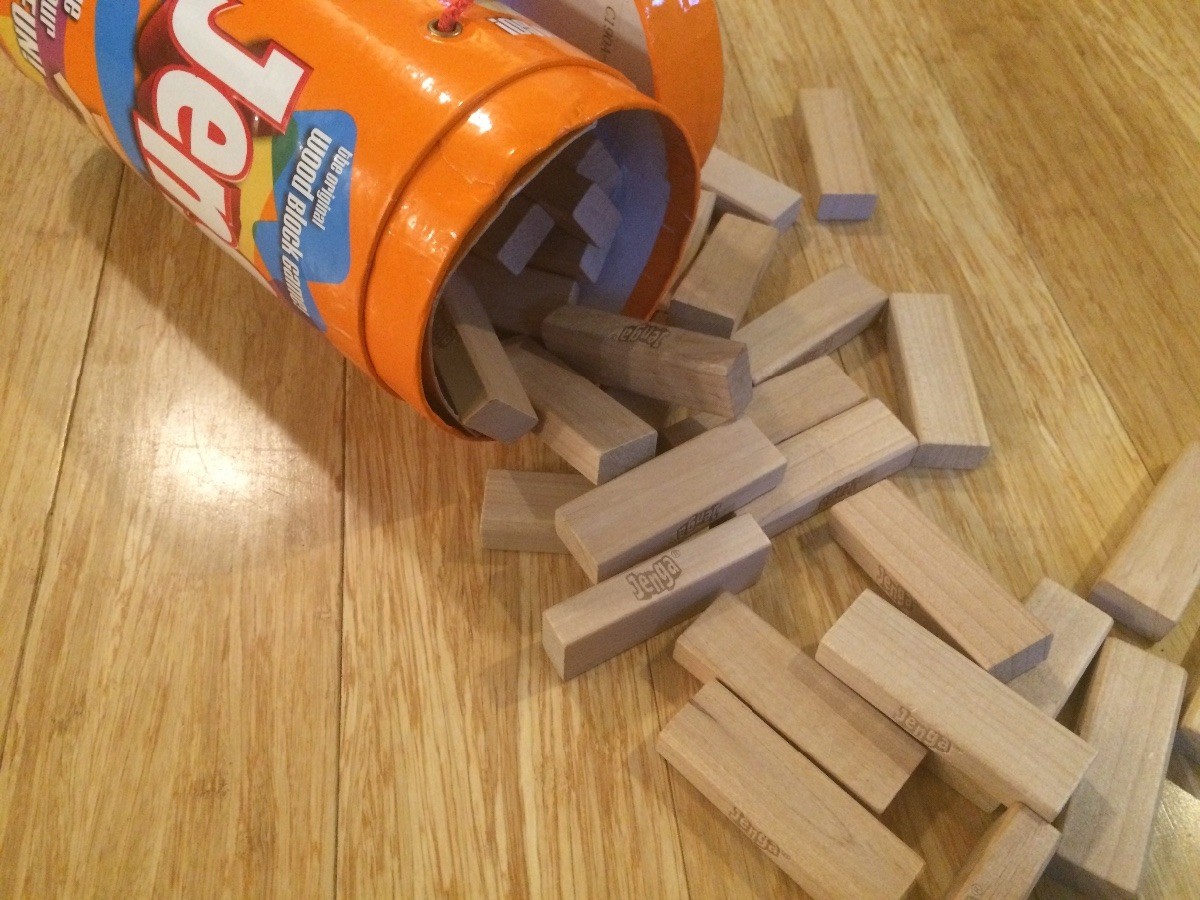
The game ends when any portion of the tower collapses, caused by either the removal of a block or its new placement. A turn ends when the next player in sequence touches the tower or when 10 seconds have elapsed since the placement of a block, whichever occurs first. A block may be touched or nudged to determine whether it is loose enough to remove without disturbing the rest of the tower, but it must be returned to its original position if the player decides to move a different one. Once a level contains three blocks, it is complete and may not have any more blocks added to it. Each player may use only one hand to touch the tower or move a block at any given time, but may switch hands whenever desired. Starting with the one who built the tower, players take turns removing one block from any level below the highest completed one and placing it horizontally atop the tower, perpendicular to any blocks on which it is to rest. A plastic tray provided with the game can be used to assist in setup. The blocks within each layer are oriented in the same direction, with their long sides touching, and are perpendicular to the ones in the layer immediately below. To begin the game, the blocks are stacked into a solid rectangular tower of 18 layers, with three blocks per layer. Blocks have small, random variations from these dimensions so as to create imperfections in the stacking process and make the game more challenging. Each block is three times as long as it is wide, and one fifth as thick as its length – 1.5 cm × 2.5 cm × 7.5 cm (0.59 in × 0.98 in × 2.95 in). The same piece type and shape can be used in both normal size and giant size, although it may look slightly different due to being twice as thick.Jenga is played with 54 wooden blocks. The thickness of the pieces is double, but they are the same length as standard Jenga pieces. Each piece has 6 different sides to it.Ī big Jenga set is made up of 12×12×60mm pieces.

If you’re looking for a bigger challenge, go for the giant version! Difference Between Giant Jenga and Regular Jenga?Ī standard Jenga set is made up of 7x12x36mm pieces. The big Jenga pieces have the same number of each type of piece as the standard set, but the pieces are twice as long and have twice the thickness. They can be used to fill a giant 2×4 tower. They are 5 times bigger than the regular pieces. The only difference between the sets is the size of each block and the height of the stack. There are 54 blocks in a standard Jenga set and 54 in the Big Jenga set. If you use a bigger piece (60mm) then you will have 2 pieces of every board size, totaling 284. If you use a bigger piece (36mm) then you will have 3 pieces of each board size, totaling 172.

If you make your giant 2×4 the same size as a piece on the left (18mm) then you will have 2 pieces of each board size, totaling 94. There are 54 blocks in the standard Jenga and 60 blocks in the big Jenga set. This continues until either the player removes the last block and causes the tower to fall, or they can put the last block back on top of the tower without causing it to fall.Ī post shared by JENGA How Many 2×4 Do I Need to Make a Giant Jenga? Then, they must remove another block and place it on top of the first block. The player begins by removing one block from the tower and placing it on top. The game is typically played with 54 wooden blocks. The goal is to be the last player to successfully remove and place blocks without causing the tower to fall.

It makes it fun to play and being an eco-friendly option makes it an awesome toy. Jenga is a popular game that involves stacking wooden blocks in a tower, and then taking turns removing blocks one at a time and balancing on the top until the tower collapses. Difference Between Giant Jenga and Regular Jenga? How Many 2×4 Do I Need to Make a Giant Jenga?


 0 kommentar(er)
0 kommentar(er)
